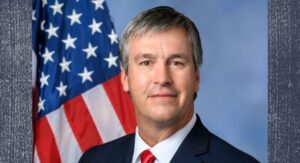When is a wall not a wall? GOP redefines Donald Trump’s border wall
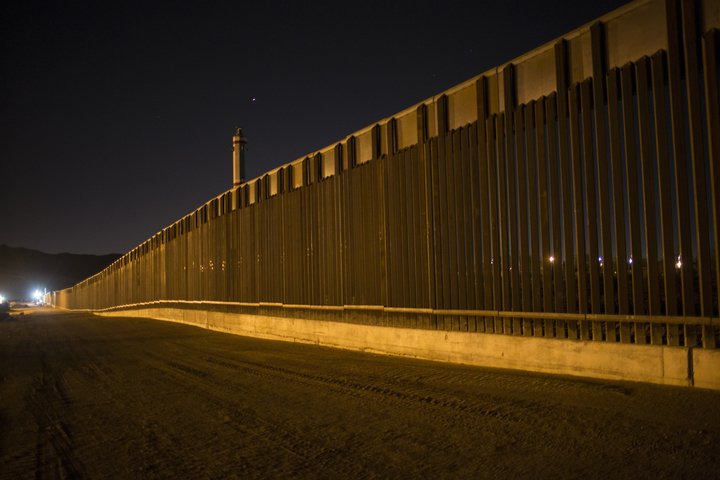
Congressional Republicans have a new talking point about President Donald Trump‘s border wall: It’s not really a wall at all. Instead, the wall is “a bit of a metaphor as to border security,” in the words of Rep. Mario Diaz-Balart of Florida. Or, a “quote, wall,” as Sen. John McCain of Arizona put it: A combination of drones, towers, anti-tunneling devices and the like that add up to enhanced border security. The issue arose this week as Congress squabbled over government-wide spending legislation, including money for security measures along the U.S.-Mexico border. After the president backed off his demands in face of Democratic objections, the bill is not expected to include money specifically designated for constructing the “big, beautiful” border wall Trump repeatedly promised during the campaign. Instead the legislation will pay for other border security measures, perhaps including access roads and gates and technological improvements of various kinds. That might seem to fall short of Trump’s commitments. But according to Republicans like McCain and Diaz-Balart, Trump’s promised wall may be better understood as a figure of speech anyway. “In my view you’ve got to have an interpretation of a, quote, wall as a barrier to illegal drugs, illegal people, these gangs that are coming from the Central American countries, and that means using every bit of technology that you have,” said McCain, who dined with Trump at the White House Monday night. As for whether the president shares his views, McCain said: “I believe that he is at least considering that definition.” Experts and lawmakers of both parties have long dismissed the notion of a physical wall along the 2,000-mile border as unnecessary, impractical and excessively expensive, especially on portions of the border that run through the Rio Grande or sovereign Indian land. Cost estimates top $20 billion, and even Republicans dismiss Trump’s oft-repeated promise that Mexico will end up paying for it. Republicans in border states are particularly skeptical and none have embraced Trump’s promise of a physical wall. Homeland Security Secretary John Kelly has acknowledged there won’t be a wall “from sea to shining sea” and instead has discussed a combination of structures, technology and manpower. But Kelly has been firm that there would be some new physical structures at the border. Republicans who faced uncomfortable questions this week about the need to pay for an actual wall found refuge in Kelly’s positioning. “Listen to the way he defines it — that’s what we’re working on,” said Sen. John Hoeven, R-N.D. “This is about wall, fencing, repairs, technology, people, all in the right balance to do the best job. Boy, that seems pretty reasonable.” But some immigration hard-liners were outraged as fellow Republicans debated about what constituted a wall. “The pro-amnesty people are trying to redefine the word ‘wall,’” said Rep. Steve King, R-Iowa. “They don’t want security at the border, they never have, and we should not let them play linguistic or semantics games to try to pull down a mandate that the American people commanded when they went to the polls.” As for Trump himself, his description of his promised border wall has evolved since he first announced the plan during his campaign kick-off speech. “It is way past time to build a massive wall to secure our southern border – and nobody can build a bigger and better wall than Donald Trump,” he declared that June day. During the campaign, he repeatedly described an “impenetrable physical wall” along the length of the southern border that would be built from concrete, rebar and steel and stand as high as his venues’ ceilings. The wall would not have to be contiguous, he sometimes allowed, thanks to natural barriers. And it would have “a big, beautiful door” for people to enter legally. The physical wall would be enhanced with technology, including above-and below-ground sensors, towers, and aerial surveillance, he said. After the election, Trump seemed to relax his expectations, telling “60 Minutes” that he would be OK with a fence along certain stretches — though he maintained a wall remained more appropriate for others. But as recently as Tuesday Trump was back to touting his wall, insisting at a White House event: “The wall’s gonna get built” and the building will start “soon.” Republished with permission of the Associated Press.
Mayors grapple with grant threat after meeting with Jeff Sessions

Mayors from several U.S. cities threatened with the loss of federal grants emerged from a meeting with the attorney general Tuesday saying they remain confused about how to prove their police aren’t prohibited from cooperating with immigration authorities — a requirement for the money. The Justice Department has warned some jurisdictions that they could lose some law enforcement grant money if they don’t prove their local police and sheriffs are able to share information with federal immigration authorities about the citizenship status of people in their custody. Attorney General Jeff Sessions has labeled cities that bar such information-sharing as “sanctuary cities.” “We want all jurisdictions to enthusiastically support the laws of the United States that require the removal of criminal aliens, as many jurisdictions already do,” Sessions said in a statement released after the meeting with representatives of the U.S. Conference of Mayors. But the officials who met with Sessions said practical questions remain about how to follow the rules. For example, does that mean a sheriff’s department must tell Immigration and Customs Enforcement about an inmate’s incarceration by phone? Or will an inmate’s fingerprint information, taken by the jail and then shared with the FBI and ICE, be enough? And how long can a local jail hold someone for immigration authorities without violating their rights? “We got more clarity than we’ve ever received, but we also have other thorny issues to sort through,” said Jorge Elorza, the mayor of Providence, Rhode Island, after the hour-long meeting. It was the first time the delegation of mayors met with Sessions since the department sent nine jurisdictions letters on Friday warning they would lose key grant money unless they document cooperation with immigration authorities. The jurisdictions, which include the state of California and major cities like Chicago, New York and Philadelphia, were places the Justice Department’s inspector general previously identified as having barriers to information-sharing among local police and immigration officials. Some disputed they met the “sanctuary city” title. New Orleans Mayor Mitch Landrieu, whose city received one of the letters, said he provided Sessions with proof of compliance during Tuesday’s meeting but remained stunned the city received a warning in the first place, as it drafted its policies in consultation with federal immigration and Homeland Security officials. The delegation also included mayors from Columbia, South Carolina; Gary, Indiana; and Austin, Texas. The meeting touched on a number of other concerns related to the Trump administration’s immigration policies they said remain confusing. On a number of immigration issues, “we hear very different messages from (Homeland Security), DOJ and also the White House,” Elorza said. “Just give us clarity and please have one, clear policy so we can know where we stand.” Republished with permission of The Associated Press.
Dems say Donald Trump can avert shutdown risk if he relents on wall
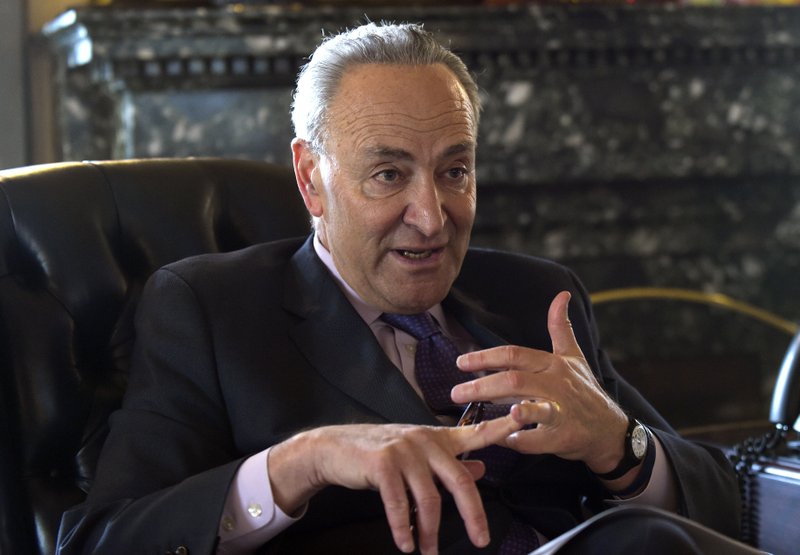
President Donald Trump could avert the risk of a government shutdown next weekend by stepping back from his demand that lawmakers fund his promised border wall with Mexico in a must-pass spending bill, Congress’ two top Democrats said Monday. “If the president stepped out of it, we could get a budget done by Friday,” Senate Minority Leader Chuck Schumer, D-N.Y., said Monday in a conference call with reporters, referring to Democratic and Republican budget negotiators. House Minority Leader Nancy Pelosi, D-Calif., agreed. She said that while Trump had promised during his campaign to build the barrier, “He did not promise that he would take food out of the mouths of babies” and cut programs for seniors, education and the environment to pay for it. She called the wall an “immoral, ineffective, unwise proposal.” Democrats timed their call to mark the 100th day of Trump’s presidency, which falls next Saturday. They said that Trump has repeatedly broken his campaign promises to help working-class Americans, and cited a GOP health care bill that Pelosi called “a moral monstrosity,” proposed cuts in domestic programs and a failure to advance tougher trade policies. Saturday is the same day the government will run out of money unless lawmakers pass legislation financing federal agencies. White House officials and leaders of both parties have said they don’t want a government shutdown. But administration officials have continued to demand that lawmakers include money for the wall in the spending bill, and the proposal has emerged as the biggest stumbling block to a budget agreement. “Instead of risking a government shutdown by shoving this wall down Congress’ and the American people’s throats, the president ought to just let us come to an agreement,” said Schumer. Trump said during his campaign that Mexico would pay for the structure, estimated to cost perhaps tens of billions of dollars. Mexican officials have refused, so the White House is seeking taxpayer money for the downpayment to begin construction. In a tweet Monday, Trump said his proposed border wall would be “a very important tool in stopping drugs from pouring into our country and poisoning our youth (and many others)!” The Wall is a very important tool in stopping drugs from pouring into our country and poisoning our youth (and many others)! If — Donald J. Trump (@realDonaldTrump) April 24, 2017 Over the weekend, he tweeted, “Eventually, but at a later date so we can get started early, Mexico will be paying, in some form, for the badly needed border wall.” Eventually, but at a later date so we can get started early, Mexico will be paying, in some form, for the badly needed border wall. — Donald J. Trump (@realDonaldTrump) April 23, 2017 To mark his 100th day in the White House, Trump has announced a rally in Pennsylvania that day. Despite Trump’s dismissal that the 100-day marker is “artificial,” the White House has packed his schedule for Monday. Trump will sign executive orders on energy and rural policies, meet with the president of Argentina and travel to Atlanta for a National Rifle Association event. Top aides will also fan out around the country to promote the administration. Trump also plans to outline an ambitious tax cut plan on Wednesday, telling The Associated Press last week that it would include a “massive” tax break for both individuals and corporations. Trump would like to revive a failed effort by House Republicans to replace the Affordable Care Act, or “Obamacare.” He also hopes to use the $1 trillion catchall spending bill to salvage victories on his promised border wall, a multibillion-dollar down payment on a Pentagon buildup, and perhaps a crackdown on cities that refuse to cooperate with immigration enforcement by federal authorities. So far, negotiations have proven difficult, with disputes over the wall and health law subsidies to help low-income people afford health insurance. House members received little information from leaders on a conference call this past Saturday. White House chief of staff Reince Priebus said on NBC’s “Meet the Press” that he’s confident the spending bill will include something “satisfactory” to reflect Trump’s desire to build a wall. The legislation would keep the government running through Sept. 30, the end of the fiscal 2017 budget year. “We expect the priorities of the president to be reflected,” Priebus said, citing ongoing talks with the House and the Senate. “It will be enough in the negotiation for us to move forward with either the construction or the planning, or enough for us to move forward through the end of September to get going on the border wall and border security.” Trump has repeatedly asserted that Mexico would pay for the wall, which he says is necessary to stop the flow of immigrants crossing the border illegally, as well as drug smugglers. On Obama’s health law, Priebus said he’d like to have a vote on the GOP repeal-and-replace bill in the House this week. But he insisted it didn’t make too much difference to the White House whether the vote came “Friday or Saturday or Monday.” Republished with permission of The Associated Press.
Fearing a worker shortage, farmers push back on immigration
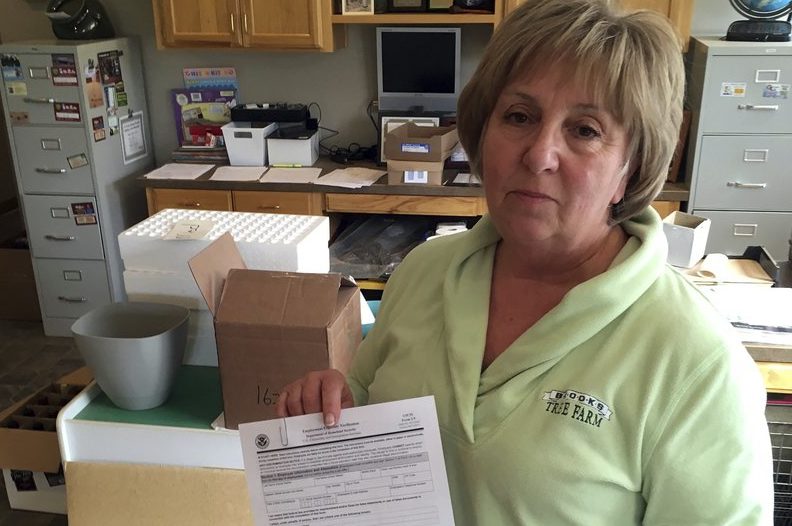
The head of Bethel Heights Vineyard looked out over the 100 acres of vines her crew of 20 Mexicans had just finished pruning, worried about what will happen if the Trump administration presses ahead with its crackdown on immigrants. From tending the plants to harvesting the grapes, it takes skill and a strong work ethic to produce the winery’s pinot noir and chardonnay, and native-born Americans just aren’t willing to work that hard, Patricia Dudley said as a cold rain drenched the vineyard in the hills of Oregon. “Who’s going to come out here and do this work when they deport them all?” she asked. President Donald Trump‘s hard line against immigrants in the U.S. illegally has sent a chill through the nation’s agricultural industry, which fears a crackdown will deprive it of the labor it needs to plant, grow and pick the crops that feed the country. Fruit and vegetable growers, dairy and cattle farmers and owners of plant nurseries and vineyards have begun lobbying politicians at home and in Washington to get them to deal with immigration in a way that minimizes the harm to their livelihoods. Some of the farm leaders are Republicans who voted for Trump and are torn, wanting border security but also mercy toward laborers who are not dangerous criminals. Farming uses a higher percentage of illegal labor than any other U.S. industry, according to a Pew Research Center study. Immigrants working illegally in this country accounted for about 46 percent of America’s roughly 800,000 crop farmworkers in recent years, according to an Associated Press analysis of data from the U.S. Departments of Labor and Agriculture. Stepped-up deportations could carry “significant economic implications,” a 2012 U.S. Department of Agriculture study said. If America’s unauthorized labor force shrank 40 percent, for example, vegetable production could drop by more than 4 percent, the study said. The American Farm Bureau Federation says strict immigration enforcement would raise food prices 5 to 6 percent because of a drop in supply and because of the higher labor costs farmers could face. In addition to proposing a wall at the Mexican border, Trump wants to hire 10,000 more Immigration and Customs Enforcement officers and has served notice that he intends to be more aggressive than the Obama administration in deporting immigrants. ICE agents have arrested hundreds of immigrants since Trump took office, though how much of a change from the Obama administration that represents is a matter of debate. Field hands have been among those targeted, with apple pickers detained in upstate New York and Guatemalans pulled over in Oregon on their way to a forest to pick a plant used in floral arrangements. It doesn’t appear the arrests themselves have put a sizable dent in the agricultural workforce yet, but the fear is taking its toll. Some workers in Oregon are leaving for job sites as early as 1 a.m. and staying away from check-cashing shops on payday to avoid dragnets. Farm employers are worried about losing their workforces. “They say, ‘Don’t go out, don’t get drunk, don’t do nothing illegal’ because they need us too. They worry too,” said Moses Maldonado, who is in the U.S. illegally and has worked for nearly four decades tending wine grapes and picking fruit in Oregon. In Los Banos, California, asparagus farmer Joe Del Bosque said workers are so afraid of being arrested in the field that he struggled to find enough hands in March to pick his crop. When immigration attorney Sarah Loftin held a recent seminar in the Oregon wine-region town of Newberg to talk about immigrants’ legal rights, she was surprised to see that about half those present were winery owners or farmers. By law, job seekers must provide documents establishing their eligibility to work in the U.S. But the papers are often fake. Many agricultural employers say that it’s not their responsibility — and that they lack the expertise — to determine if they’re genuine. At the same time, they say that U.S.-born workers have little interest at laboring in the dirt and the cold at the crack of dawn. As 18 Guatemalans in hoodies and rubber boots toiled in such conditions recently in Oregon’s Willamette Valley, their boss expressed admiration for their willingness to do the back-breaking work he said native-born Americans won’t do. “Homeless people are camped in the fir forest over there,” the farmer said, pointing to a stand of trees. “And they’re not looking for work.” He lamented that crackdowns may force him to retire because he won’t be able to find workers. Fearing reprisals from federal agents, he spoke on condition of anonymity and didn’t want even his crop identified. Some immigration hardliners say people who are in the U.S. illegally steal jobs from Americans. But a 2013 study by an economist at the Center for Global Development looked at farms in North Carolina and found that immigrant manual laborers had “almost zero” effect on the job prospects of native-born U.S. workers. “It appears that almost all U.S. workers prefer almost any labor-market outcome — including long periods of unemployment — to carrying out manual harvest and planting labor,” Michael Clemens wrote. While lobbying for visa and immigration reforms, agricultural employers are also looking into contingency plans such as mechanization or a switch to less labor-intensive crops. In Vermont, officials are considering a vocational program to train inmates in dairy farming. Dudley, the vineyard owner, isn’t optimistic about some of the alternatives. “I don’t trust that temps off the street, or jailhouse labor, or whatever alternative they come up with would work,” she said. Republished with permission of The Associated Press.
Justice Dept threatens sanctuary cities in immigration fight
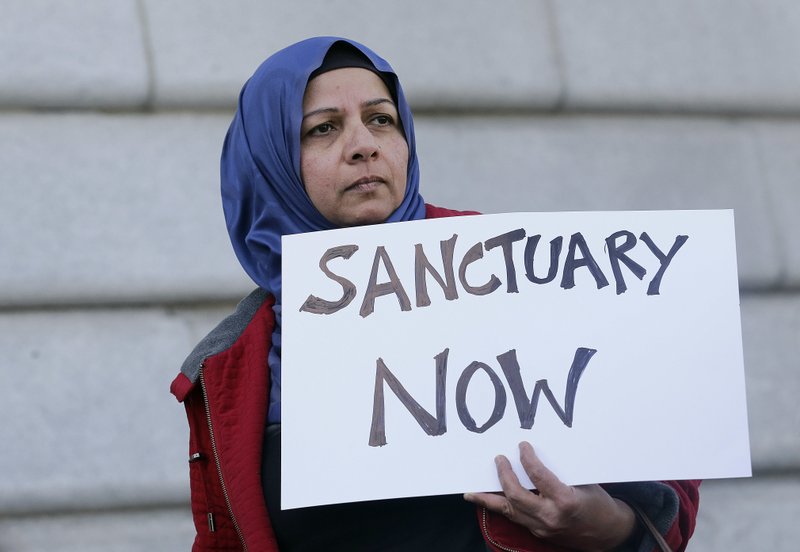
The Trump administration intensified its threats to crack down on so-called sanctuary cities that refuse to comply with federal immigration authorities, sending letters Friday to nine jurisdictions warning it would withhold coveted law enforcement grant money unless they document cooperation. The letters went to officials in California and in major cities including New York, Chicago, Philadelphia and New Orleans, all places the Justice Department‘s inspector general has identified as limiting the information local law enforcement can provide to federal immigration authorities about those in their custody. Attorney General Jeff Sessions has increasingly warned that the administration will punish communities that refuse to cooperate with efforts to find and deport immigrants in the country illegally. In a statement Friday, the Justice Department said the recipients of its letters are “crumbling under the weight of illegal immigration and violent crime.” After a raid led to the arrests of 11 MS-13 gang members in California’s Bay Area “city officials seemed more concerned with reassuring illegal immigrants that the raid was unrelated to immigration than with warning other MS-13 members that they were next,” the department said. The federal law in question says state and local governments may not prohibit police or sheriffs from sharing information about a person’s immigration status with federal authorities. Friday’s letters warn officials they must provide proof from an attorney that they are following the law or risk losing thousands of dollars in federal grant money that police agencies use to pay for anything from body cameras to bulletproof vests. The money could be withheld in the future, or terminated, if they fail to show proof, wrote Alan R. Hanson, acting head of the Office of Justice Programs, which administers the grant program, which is the leading source of federal justice funding to state and local communities. The targeted jurisdictions also include Clark County, Nevada; Cook County, Illinois; Miami-Dade County, Florida; and Milwaukee County, Wisconsin. They were highlighted in a May 2016 report by the Justice Department’s inspector general that found they have policies or rules that interfere with information-sharing among local law enforcement and immigration agents. The Orleans Parish Sheriff’s Office, for example, has a policy to decline all requests by Immigration and Customs Enforcement to keep a suspected deportable immigrant in its custody long enough for immigration authorities to arrest the person unless that person is charged with certain violent crimes, according to the report. It also pointed to a Miami-Dade County rule that allows its corrections department to honor detainer requests only if ICE agrees in writing to reimburse the county for costs and only if the inmate has a prior felony conviction, among other constraints. The Obama administration warned cities after the report’s release that they could miss out on grant money if they did not comply with the law, but it never actually withheld funds. The grants in question are based on population and support an array of programs, technology and equipment for local law enforcement agencies, which can use the money at their discretion. Sessions said earlier this week that sanctuary cities undermine efforts to fight violent gangs. Republished with permission of The Associated Press.
How communities shaped by refugees became Donald Trump country
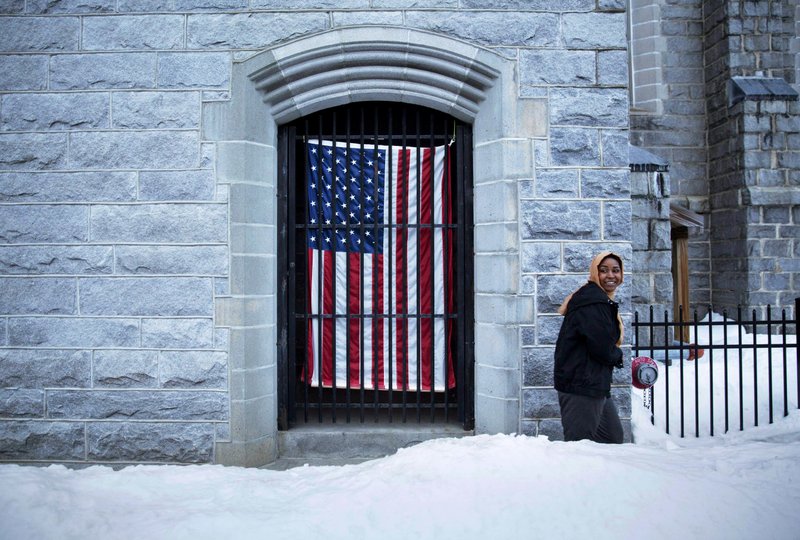
Richard Rodrigue stood in the back of a banquet hall, watching his blond-haired, blue-eyed daughter mingle among her high school classmates. These teenagers speak dozens of languages, and hail from a dozen African nations. They fled brutal civil war, famine, oppressive regimes to find themselves here, at an ordinary high school pre-prom fete in this once-dying New England mill town, revived by an influx of some 7,500 immigrants over the last 16 years. Rodrigue smiled and waved at his daughter, proud she is a part of it: “It will help her in life,” he said. “The world is not all white.” Rodrigue believes the refugees resuscitated his town — plugging the population drain that had threatened to cripple it, opening shops and restaurants in boarded-up storefronts. But he also agrees with Donald Trump that there should be no more of them, at least not now. America is struggling, he says, and needs to take care of its own before it takes care of anyone else. His working-class community, built along the banks of the Androscoggin River in the whitest state in America, is a place that some point to as proof that refugee integration can work. And yet for the first time in 30 years, voters in Androscoggin County chose a Republican for president, endorsing Trump’s nativist zeal against the very sort of immigrants who share their streets and their schools. Rodrigue knows he was born on the winning end of the American dream. His grandfather fled poverty in Quebec and moved to Maine to toil his whole life in the textile mills. He never learned English, faced hate and discrimination. Two generations later, Rodrigue owns a successful security company, lives in a tidy house in a quiet neighborhood and makes plans to send his daughter to college. Immigration worked for him. But it feels different today, as the county of 107,000 people tries to find its footing. The sprawling brick mills that line the river sit mostly shuttered. A quarter of children grow up poor. Taxpayers pick up the welfare tab. So Trump’s supporters here tie their embrace of his immigration clampdown to their economic anxieties, and their belief that the newcomers are taking more than they have earned. “There’s got to be a point in time when you have to say, ‘Whoa, let’s get the working people back up. Let’s bring the money in.’ But they keep coming, keep coming,” Rodrigue said. His community has been an experiment in immigration and all that comes with it — friendships, fear, triumphs, setbacks — and he knows that Trump’s presidency marks another chapter in that struggle for the American soul. “I guess it just boils down to: What’s enough? Is that wrong? Am I wrong? Am I bad? That’s how I feel.” ___ No one invited the Somali refugees to Lewiston. They fled bullets and warlords to eventually be chosen for resettlement in big American cities, where they were unnerved by the crime and drugs and noise. In early 2001, a few refugee families struggling to afford housing in Portland ventured 30 miles north and found a city in retreat. Empty downtown stores were ringed by sagging apartment buildings no longer needed to house workers because so few workers remained. The refugees saw possibility in Lewiston’s decay. Word spread quickly, and friends and families followed. The town morphed in a matter of months into a laboratory for what happens when culture suddenly shifts. Maine’s population is 94 percent white, and its citizens were abruptly confronted with hundreds of black Muslims, traumatized by war and barely able to speak English. Ardo Mohamed came to Lewiston in 2001. She fled Mogadishu in the 1990s, when militiamen burst into the home she shared with her parents and nine siblings, and started shooting. She watched her father die, as the rest of the family escaped into the woods. They wound up in overcrowded refugee camps, separated for years, then finally Atlanta, then Lewiston. Now she fries sambusas with her sister at a shop she owns downtown. “We wanted to be safe,” said the mother of five, “just like you do.” When the refugees began arriving, Tabitha Beauchesne was a student at Lewiston High School. Her new classmates were poor, but Beauchesne was poor, too. She grew up in a struggling family in housing projects downtown. It felt to her then, and it still feels to her now, that the refugees got more help than her family. “They just seemed to take over,” she said. She doesn’t consider herself racist, though acknowledges that race and religion likely play a role in her sense that the refugees overwhelmed her community. The African Muslims, many of whom wear hijabs, stand out far more than her French-Canadian ancestors did when they arrived generations ago, she said. That perception — one of being inundated by a culture so different from her own — ingrained in her a sense of injustice so deep it persists to this day. She’s now a stay-at-home mother of two, and she left Lewiston to move to another school district in the county because she believes the refugee students monopolize teachers’ attention. Once a Barack Obama supporter, Beauchesne turned to Trump — and she cheers his efforts to curb the flow of refugees into the United States. She wants Trump to design a tax system that funnels less of her money to aiding those from other countries. “I just don’t like giving money away that’s not benefiting me and, not to sound selfish, but then seeing it benefit other people,” she said. “As a business owner, my husband wouldn’t donate $500 to the Salvation Army if we couldn’t afford it. Our country needs to do the same thing.” Taxpayers do help refugee families. Maine offers a welfare program called General Assistance, a combination of state and city funds, which provides impoverished people with vouchers for rent, utilities and food. In 2002, at the beginning of the immigrant influx, the city handed out about $343,000
Donald Trump targets visas program for highly skilled workers
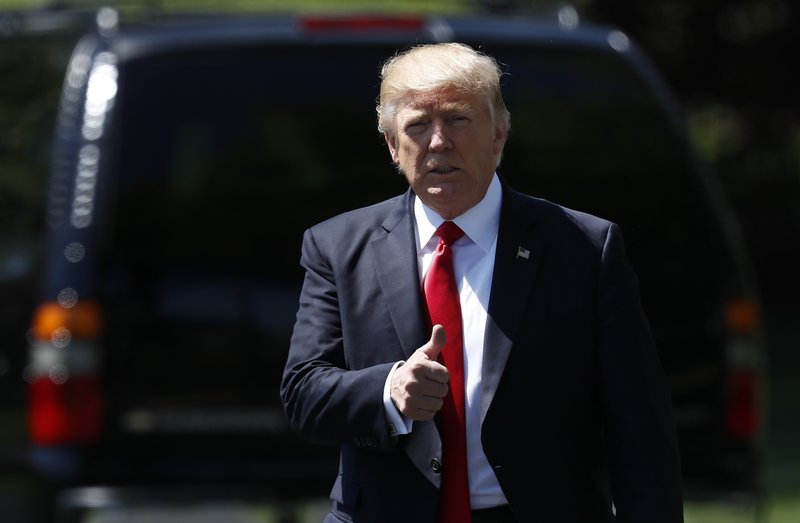
President Donald Trump hopes to revive the economic populism that helped drive his election campaign on Tuesday, signing an order in politically important Wisconsin to tighten rules on technology companies bringing in highly skilled foreign workers. At a the headquarters of a big-name tool manufacturer, Trump is expected to sign an order aimed at curbing what his administration says are abuses in a visa program used by U.S. technology companies that harm American workers. Dubbed “Buy American, Hire American,” the directive follows a series of recent Trump reversals on economic policies. The president is to sign the directive at Snap-on Inc. in Kenosha, Wisconsin, a state he narrowly carried in November on the strength of support from white, working class voters. Trump currently has only a 41 percent approval rating in the state. He is targeting the H-1B visa program, which the White House says undercuts American workers by bringing in large numbers of cheaper, foreign workers, driving down wages. The tech industry has argued that the H-1B program is needed because it encourages students to stay in the U.S. after getting degrees in high-tech specialties — and companies can’t always find enough American workers with the skills they need. Trump has traveled to promote his agenda less than his recent predecessors. White House spokesman Sean Spicer said he wanted to visit “a company that builds American-made tools with American workers.” The new order would direct U.S. agencies to propose rules to prevent immigration fraud and abuse in the program. They would also be asked to offer changes so that H-1B visas are awarded to the “most-skilled or highest-paid applicants,” said administration officials who spoke only on the condition of anonymity despite the president’s frequent criticism of the use of anonymous sources. The officials said the order also seeks to strengthen requirements that American-made products be used in certain federal construction projects, as well as in various federal grant-funded transportation projects. The commerce secretary will review how to close loopholes in existing rules and provide recommendations to the president. The order specifically asks the secretary to review waivers of these rules in free-trade agreements. The waivers could be renegotiated or revoked if they are not benefiting the United States. Trump’s visit to Wisconsin takes him to the congressional district of House Speaker Paul Ryan, who won’t be joining the president because he’s on a congressional trip visiting NATO countries. Trump campaigned on populist promises to stand up to China, which he contended was manipulating its currency and stealing American jobs, and to eliminate the Export-Import bank, which he billed as wasteful subsidy. In a series of interviews last week, Trump reversed himself on both positions And while he has long pledged to support American goods and workers, his own business record is mixed. Many Trump-branded products, like clothing, are made overseas. And his businesses have hired foreign workers, including at his Palm Beach club Mar-a-Lago. During his campaign, Trump said at one point that he supported high-skilled visas, then he said he opposed the program. At one debate, he said: “It’s very bad for our workers and it’s unfair for our workers. And we should end it.” Potential changes could be administrative or legislative and could include higher fees for the visas, changing the wage scale for the program or other initiatives. Critics say the program has been hijacked by staffing companies that use the visas to recruit foreigners — often from India — who will work for less than Americans. The staffing companies then sell their services to corporate clients. Employers, including Walt Disney World and the University of California, San Francisco, have laid off tech employees and replaced them with H-1B visa holders. U.S. workers are sometimes asked to train their replacements to qualify for severance packages. Ronil Hira, a professor in public policy at Howard University and a critic of the H-1B program, said Trump’s planned order is “better than nothing.” But he added, “It’s not as aggressive as it needs to be.” Trump carried Wisconsin in November by under 23,000 votes — less than 1 percentage point — making him the first Republican to win the state since 1984. He campaigned on the promise of returning manufacturing jobs that have been lost in Upper Midwest states. Snap-on makes hand and power tools, diagnostics software, information and management systems, and shop equipment for use in various industries, including agriculture, the military and aviation. It has eight manufacturing sites in North America and employs about 11,000 people worldwide. Republished with permission of The Associated Press.
Jeff Sessions to tour Arizona-Mexico border Tuesday

U.S. Attorney General Jeff Sessions on Tuesday will take a tour of the U.S.-Mexico border during a visit to Arizona. Sessions will tour what is mostly rough terrain along the international border in Nogales, Arizona, about roughly 70 miles (113 kilometers) south of Tucson. Sessions has made immigration enforcement a key Justice Department priority, saying he will speed up deportations of immigrants in the country illegally who were convicted of federal crimes. Sessions has also defended federal immigration authorities who make arrests at courthouses, a practice advocates and the California Supreme Court chief justice say impedes on people’s access to justice and deters immigrants from reporting crimes and going to court. The Tucson Sector, which comprises most of Arizona, was once the busiest area for illegal border crossings and drug smuggling, but movement has shifted in the past few years to the Rio Grande Valley in Texas. The Arizona area saw about 65,000 arrests last fiscal year, roughly half the number agents made in 2012, according to Border Patrol data. Marijuana seizures have also dropped by about 28 percent from 1 million pounds in 2012 to 728,000 last year. In March, Sessions said that the Justice Department will expand an existing program aimed at holding deportation hearings for immigrants while they are still in federal prison known as the Institutional Hearing Program. Holding the hearings before the inmates’ sentences are finished would allow the government to deport them immediately when they’re released, as opposed to waiting until they go through an immigration court. Sessions’ proposal would set up 14 federal prisons and six contract facilities for immigration removal proceedings. Following the border tour, Sessions will deliver a keynote speech at an International Association of Chiefs of Police conference in Litchfield Park, Arizona. He’ll also speak with service members at Luke Air Force Base near Phoenix. Republished with permission of The Associated Press.
Mike Rogers: Protecting our sovereignty, borders and the taxpayer

Great nations throughout history are those that control their own sovereignty. Sovereignty can be defined in different ways, but starts with the freedom to act in the nation’s best interest and controlling who crosses their borders. President Donald Trump has made putting America first a priority for his Administration. I fully support him in this effort and am working hard in Congress to make it a reality. President Trump promised to build a wall on our southern border. I recently introduced legislation that will help make the wall a reality without any additional costs to America’s taxpayer. Each year the countries south of our border benefit from an estimated $50 billion windfall from the U.S. in the form of remittances. In 2015, Mexico received over $24 billion in remittances sent from the United States. My bill, H.R. 1813: the Border Wall Funding Act of 2017, would impose a fee on remittance transactions to South and Central America. The fee revenue would go to an account dedicated to building the wall. The legislation is endorsed by FAIR (Federation for American Immigration Reform) and NumbersUSA. It is time to finally have some real action on securing our borders. I have also introduced the American Sovereignty Restoration Act of 2017, which would end the United States’ involvement in the United Nations (UN). The American taxpayer should not have to bankroll an organization that tries to infringe on our Constitutional rights and supports terrorists over our great ally Israel. The United States does not need the permission of the UN to defend our values and freedoms. I believe we should put America first and get out of the UN. I stand with President Trump on these issues and will continue to push these bills forward. I want to hear from you on this or any issue. Please sign up for my e-Newsletter by visiting mikerogers.house.gov. To stay up to date, you can also like me on Facebook at Congressman Mike D. Rogers, follow me on Twitter, Pinterest and Instagram at RepMikeRogersAL, on Tumblr at repmikerogersal.tumblr.com and you can also subscribe to my YouTube page at MikeRogersAL03. ••• Mike Rogers is a member of U.S. Congress representing Alabama’s 3rd Congressional District.
Border wall bids include tourist attraction, solar panels
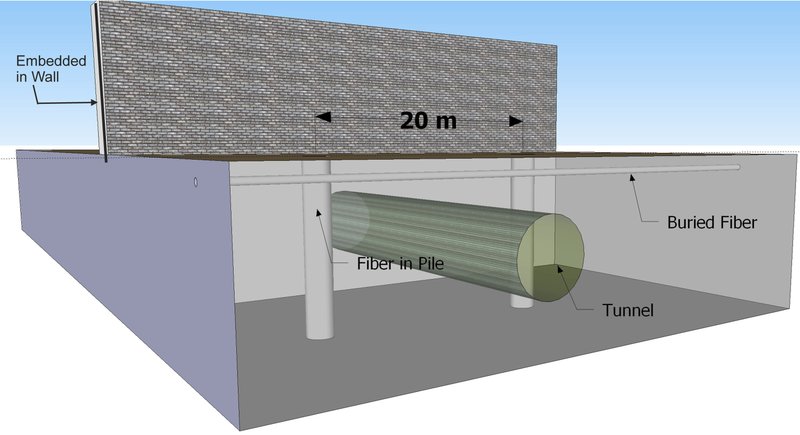
Tuesday was the deadline for companies to propose designs for President Donald Trump‘s border wall with Mexico. U.S. Customs and Border Protection will ask several of the bidders to build prototypes in San Diego. The government won’t identify companies until contracts are awarded around June 1 — and even then, only the winners — but some bidders released plans on their own. ___ SOLAR PANELS Gleason Partners LLC of Las Vegas proposes solar panels to cover sections of the wall. The panels would provide electricity for lighting, sensors and patrol stations along the wall. Sales of electricity to utilities could cover the cost of construction in 20 years or less, according to the company. Power could also be sold to Mexico. “I like the wall to be able to pay for itself,” said managing partner Thomas Gleason. ___ TOURIST ATTRACTION Crisis Resolution Security Services Inc. of Clarence, Illinois, proposes a wall that is 56 feet (17 meters) high and 22 feet (7 meters) wide at the top — with plenty of room to allow tourists to enjoy desert views. The height — nearly twice what the government envisions — would deter climbers, and its width would give the structure longevity, said chief executive officer Michael Hari. ___ NUCLEAR WASTE Clayton Industries Inc. of Pittsburgh proposes storing nuclear waste along the wall in trenches that are at least 100 feet (30 meters) deep. Money already collected by the U.S. Department of Energy from people who benefit from nuclear power would help pay for the wall. The bid includes an option for hardware to convert the nuclear waste to energy. ___ ARTWORK ON BOTH SIDES OF THE BORDER Concrete Contractors Interstate of San Diego proposed a polished concrete wall augmented with stones and artifacts specific to areas on the 2,000-mile (3,218-kilometer) border. Russ Baumgartner, CEO of the company, says the wall should be “a piece of art.” Customs and Border Protection’s solicitation says the wall should be “aesthetically pleasing” from the U.S. side. Baumgartner wants to decorate both sides. ___ BALLISTIC CONCRETE DarkPulse Technologies of Scottsdale, Arizona, proposes a concrete wall that can withstand tampering or attacks of any kind. “You could fire a tank round at it and it will take the impact,” said company founder Dennis O’Leary. Fiber sensors would be embedded in the concrete to immediately alert officials to any attempts to climb over or tunnel under the wall. It would be coated with a slick coating that would prevent climbing. ___ NO BORDER Otra Nation, a group of U.S. and Mexican citizens, proposed the world’s first shared co-nation along the border “open to citizens of both countries and co-maintained by Mexico and the United States of America.” It would also create “nodes of cultural production” such as libraries, museums, galleries and workshops between San Diego and Tijuana, Mexico, and other spots with cities on both sides of the border. It would prohibit oil drilling and mining and create a “hyperloop transportation system” for people and cargo. Republished with permission of The Associated Press.
Mo Brooks joins House colleagues in leading effort to defund sanctuary cities
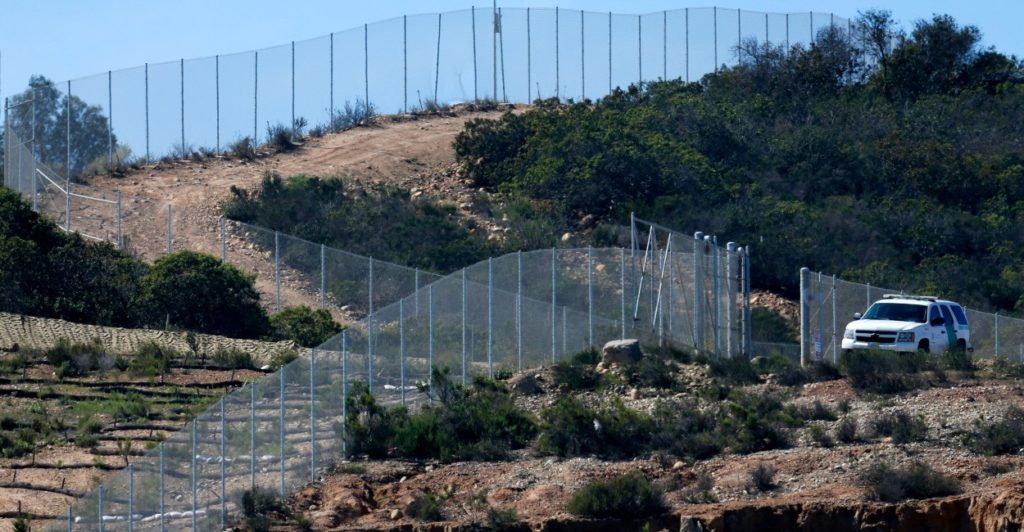
In an effort led by Alabama 5th District U.S. Rep. Mo Brooks, Arizona 4th District U.S. Rep. Paul Gosar, Iowa 4th District U.S. Rep. Steve King and Colorado 4th District U.S. Rep. Ken Buck — a group of House Republicans are urging Congressional appropriators to defund “sanctuary cities” that prevent law enforcement officials from faithfully executing America’s immigration laws: In a letter sent Tuesday, the four sponsors and 35 additional co-sponsors submitted appropriations language requesting the House Appropriations Committee prevent funds from going to “sanctuary cities.” “Sanctuary cities” are municipalities that have limited their cooperation with federal officials regarding undocumented immigrants, in order to help illegal immigrants avoid deportation. Currently, there are around 340 sanctuary jurisdictions across the U.S. actively obstructing federal law enforcement protecting illegal immigrants in sanctuary cities, according to a recent study by the Center for Immigration Studies. The letter follows an executive order President Donald Trump issued on his fifth day in office, whereby allowing Attorney General Jeff Sessions and Homeland Security Secretary John Kelly to decide whether sanctuary cities would be eligible for federal grants. “Congress has an opportunity to work with the Trump Administration and enforce our nation’s immigration laws with respect to sanctuary cities,” said Congressman Mo Brooks. “Cities and localities who have refused to comply with federal immigration laws and knowingly shield dangerous felons from removal by ICE present a clear danger to our Republic. According to an ICE report from March of 2017, there are an estimated 300 cities and counties obstructing federal immigration agents from doing their jobs to deport dangerous criminals, thereby intentionally endangering Americans.” Rep. Gosar points to the U.S. Constitution as the reason he and his colleagues are taking action. “The concept of ‘sanctuary city’ policies is in direct opposition to the Rule of Law and our Constitution. Article 1, Section 8, Clause 4, gives Congress clear jurisdiction on immigration matters,” stated Gosar. “I’m pleased to see President Trump and Attorney General Sessions lead on this issue, but the House must also act by using the power of the purse. It’s long past time for Congress to crack down and defund sanctuary city policies that are proven to be deadly and put the security of our communities at risk.” The House has voted and passed language that prohibits federal funds from going to sanctuary cities five different times in recent years. “Sanctuary cities force the federal government to spend more money on immigration enforcement,” added Rep. Buck. “We must assert federal authority on federal issues and cut off funding for cities that violate the rule of law, which is what this appropriations request does.” The full text of the appropriations language request can be found HERE. The list of 35 House members who cosponsored this language request include Representatives Abraham, Arrington, Babin, Barletta, Brady, Brat, Mo Brooks, Buck, Cramer, DeSantis, Duncan, Farenthold, Franks, Gosar, Grothman, Hensarling, Hice, Hunter, Sam Johnson, Jones, Kelly, Steve King, Lamborn, Marino, McCaul, McClintock, Meadows, Olson, Ratcliffe, Rooney, Rouzer, Schweikert, Wagner, Webster and Yoho.
Immigrant’s bid to avoid deportation comes to Supreme Court
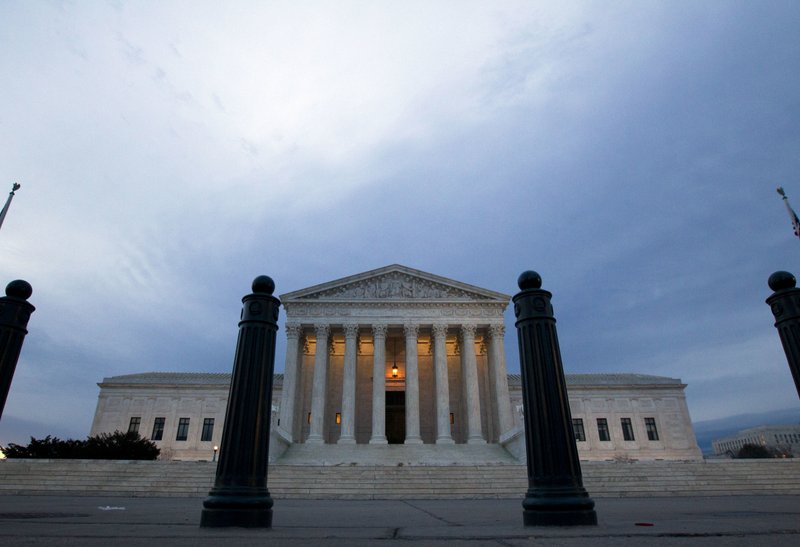
The Supreme Court is taking up the case of a longtime U.S. resident who is facing deportation to South Korea after pleading guilty to a drug crime based on his lawyer’s bad advice. The justices are hearing arguments Tuesday in an appeal by Jae Lee, who had lived in the United States for 35 years and has never been back to South Korea since coming to the United States when he was 13. The case has taken on increased importance because President Donald Trump has promised to step up deportations, with a special focus on immigrants who have been convicted of crimes. The American Bar Association has estimated that one of every 10 criminal defendants is not an American citizen. Lee agreed to plead guilty to possession of ecstasy with intent to distribute after his lawyer, Larry Fitzgerald, assured him that doing so would not make him subject to deportation. The lawyer was wrong. The issue in Lee’s appeal is whether the lawyer’s recommendation to take the deal offered by prosecutors was so bad that it amounts to a violation of Lee’s constitutional right to a lawyer. Both sides agree that Fitzgerald’s performance was deficient in representing Lee. The Supreme Court ruled in 2010 that immigrants have a constitutional right to be told by their lawyers whether pleading guilty to a crime could lead to their deportation. But Lee almost must show that the bad lawyering mattered to the outcome of the criminal case. The federal appeals court in Cincinnati ruled that the evidence against Lee was overwhelming and that he would have been convicted had he rejected the plea offer and taken his chances at trial. Other appeals courts around the country have sided with immigrants in similar circumstances. The Supreme Court is expected to set a national standard. Fitzgerald lacked experience in immigration law, did not consult an immigration lawyer and was unaware that the charge Lee was facing would result in mandatory, automatic deportation, according to a magistrate judge’s finding. Lee argued in court papers that a competent lawyer would have sought a better deal that preserved his options for fighting deportation. Failing a deal, Lee said he would have insisted on a trial. He has been in custody for seven years while trying to avoid being deported. Alabama is leading 19 other states in backing the administration’s argument that the appeals court ruling should be upheld. The Obama administration Justice Department had previously urged the Supreme Court to turn down the appeal and leave the lower court ruling in place. The new administration announced in February that any immigrant in the country illegally who is charged with or convicted of any offense, or even suspected of a crime, will now be an enforcement priority for deportation. Some 11 million immigrants are living illegally in the U.S. Immigrant rights groups and the bar association are among those siding with Lee. Jenny Roberts, a law professor at American University in Washington, said the case calls attention to the harsh consequences immigrants can face, despite their long-standing ties to the country. “This case is about the unexpected people who are marked for deportation, about someone whose parents brought him here,” said Roberts, who helped write a legal brief from immigrant legal advocates in support of Lee. The case is Lee v. U.S., 16-327. Republished with permission of The Associated Press.


